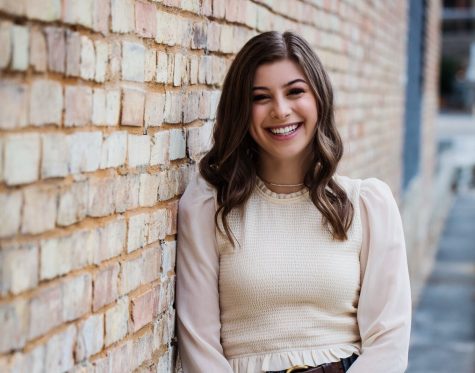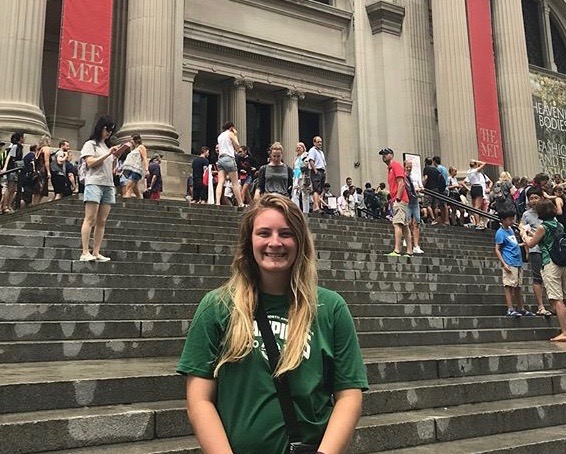Alexa Lauer’s injuries introduced her to the biomedical research field

More stories from Courtney Collar

Senior Alexa Lauer has a rap sheet of breaks and sprains longer than some people accumulate during their whole life. At five, she broke her wrist. At seven and nine, she broke her ankle. When she was eleven, she broke her pinky finger. Because she kept spraining it, she was in physical therapy at age thirteen for her ankle.
Despite all of these injuries, Alexa’s most problematic injury was in her back.
“I did physical therapy,” Alexa said. “I [went to the] chiropractor. I did steroid injections. They all said, ‘This is not helping. Go [consult] a surgeon.’ ”
And she did. A year or so prior, Alexa had bulged a disc in her back. Then, the summer before junior year, she herniated that disk while horseback riding. During winter break that same year, Alexa underwent a minimally invasive discectomy.
“It’s a really minimal [procedure],” Alexa said. “I knew what was happening. I knew there wasn’t really anything [bad] that could happen. I knew that it was gonna be okay.”
During a discectomy, part of the disc causing issues is removed. Because of its basic nature, Alexa was up and walking the very same day, yet Alexa was unable to play soccer for four months.
Usually, Alexa would have been in the goalie box blocking shots, but unfortunately for her, her recovery interfered with her soccer season. Alexa was still a part of the team and did all she could for her teammates, so she went to all the games and kept stats for them.
“That was hard,” Alexa said, “but I still got to be on the team, and I still got to make the memories with everybody. That’s what high school soccer is about. So, even though I couldn’t play sports, I still got to have the experience of playing the sport.”
Her recovery was also hard for another reason: school. Alexa was not allowed to carry more than five pounds for at least a month after her surgery. While this may not seem like a large complication, it in fact was. Nevertheless, Alexa overcame the challenge of carrying backpacks and heavy books by making many trips to her locker and with some sisterly assistance.
On the other hand, all of Alexa’s injuries did have a positive outcome. They helped her discover her interest in biomedical research.
“It was interesting [to] have spent so much time at the doctor’s [office], learning about all my injuries and about how they happened, why they happened, and what I could have done to make it not happen,” Alexa said. “I like learning about that kind of stuff.”
In fact, Alexa even watched her own MRI. After she had it done, her chiropractor asked to see it and then invited her to watch it with him, to which she said yes.
She was fascinated by her discs. Normally, they appear in a light gray color. However, the disc she had injured appeared black. Alexa had so many questions like why was it black compared to the others? This desire to know why and how things happen led her to the biomedical field.
Originally, Alexa was interested in biomedical engineering. She joined robotics to test it out. Although she loved the people in robotics, she determined engineering wasn’t for her.
“I just didn’t like all the regulations on it,” Alexa said. “You’re working with living organisms in biomedical research, so there’s more variation of what can happen. With robots, it’s all ‘this’ happens now, and then ‘that’ happens later. It’s going to do that because you programmed it to do that, but you never know what’s gonna happen with living organisms.”
This aspect of science where there is no definite answer has always been appealing to Alexa. As a matter of fact, she’s always liked science and math much more than other subjects. For the past two years, Alexa has been squeezing as many science classes– and math to a lesser extent– as she could into her schedule. She’s currently in AP Biology, AP Calculus, and AP Physics. Alexa even took physics online in the past to make more room in her schedule.
“It wasn’t even like a question of whether or not I wanted to take two science classes,” Alexa said. “It was what science classes I wanted to take. It always had to be science for me. Everything fits together, and all the subjects are really just different aspects of the same thing.”
Two classes, in particular, have really helped prepare her for her future career in biomedical research: anatomy and biology. They’ve helped her gain a background knowledge of which parts of an organism work together on levels as small a cell or as large as a muscle.
Furthermore, Alexa’s biology class has helped her in another endeavor. This year, Alexa joined HOSA. However, which event she wanted to compete in was the source of a dilemma. She had the choice of biomedical research or pharmaceuticals.
“Biomedical research is actually really broad,” Alexa said. “So I could do whatever I wanted. I went with biomedical research because it just kind of fits in with the pharmaceuticals.”
With the decision to take on the biomedical research event comes a lot of work and preparation. Fortunately, AP Biology has helped. Biology has taught her how to use much of the equipment she will be tested on in the competition.
In a greater sense, both the classes and HOSA have helped prepare her for college and the workforce for that same reason.
“I already will know how everything works in the lab,” Alexa said. “I won’t be walking in just like ‘fresh meat’ having no clue what to do.”
So far, HOSA has cemented her attraction to the biomedical field. Not only that, but it has helped her love of research in general. While she got a fresh perspective on her own injuries, she learned she prefers tangible research.
“I like all types of research, “ Alexa said. “I enjoy learning about different things and delving into how things work. I always knew I didn’t want to be a doctor, but I liked medicine. I didn’t want to see in person the effects of what was happening. But, I liked how they are happening, so that’s why I chose research.”

Courtney Collar is a senior and is entering her second year on staff for The Central Trend. In her spare time, you will find her dancing for FHC's varsity...


























































































